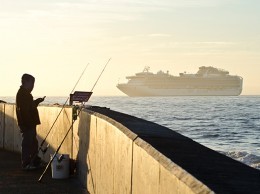The travel and tourism industry throughout the tri-county coastal area had a banner year in 2014. For the year ahead, industry professionals expect more growth, but a slightly slower pace.
Overall, the total number of visitors to California was forecasted to grow about 3.4 percent in 2014, and the most recent data from Visit California shows expectations were mostly met. In 2015, visitation is forecasted to grow by just 2.1 percent.
On the South Coast, Santa Barbara still holds the title of the most popular destination in the region and its growing allure with travelers can be seen in the numbers.
The 2013-14 fiscal year brought in more transient occupancy tax, or TOT, revenue than any previous year, with a total that was 14.6 percent higher than the previous fiscal year. The Santa Barbara South Coast saw a 7.4 percent increase in the average daily rate and a 3.5 percent increase in occupancy over the last year.
Visit Santa Barbara President and CEO Kathy Janega-Dykes said in 2015 average daily rates charged in Santa Barbara hotels and other lodging establishments are expected to rise 6.5 percent. Lodging occupancy is forecast to average 76.4 percent for the year.
“Travel projections and many of the trends for 2015 look very strong for Santa Barbara’s South Coast,” Janega-Dykes said. “For the first time, surveys done by MMGY Global show California as the top domestic ‘dream destination’ that people want to visit. Thirty percent of the people in this national survey were very interested in visiting Santa Barbara, with millennials ranking highest of the age groups interested in coming to Santa Barbara at 44 percent.”
The international travel market in Santa Barbara is expected to grow in the coming year as well, with affluent travelers from China and Mexico joining the European travelers who have traditionally selected the city as a vacation destination, she said.
Thanks to a new tourism business improvement district, or TBID, Visit Santa Barbara expanded its programs over the past three years.
According to the organization, TBID funds have allowed it to remain competitive in attracting visitors with a new advertising campaign, refreshed brand identity, a music marketing initiative, pop-up media dinners, expanded efforts to recruit group meetings, increased international representation, television exposure and a film incentive program.
The organization also reports strong results from these efforts. With the use of TBID funding, VSB-generated lodging revenue has increased from $28 million in 2010-11 to a projected $59 million for 2013-14.
The 2013-14 fiscal year brought a partnership with US Airways Magazine putting Santa Barbara in front of 6.5 million readers, the largest number of room nights booked since the recession, more media placements and high-profile television shows using the town as the backdrop.
Visit Santa Barbara’s 2014-15 marketing plan launched this fall and is rolling out more new programs to keep tourists flowing into Santa Barbara.
According to industry experts the Business Times spoke with, the number of hotel developments that are in the works are also a big indicator that the tourism economy will continue to add to its strong base throughout 2015.
Earlier this year Ventura’s TOT jumped by 13 percent, and in San Luis Obispo, it shot up 8.5 percent.
The Central Coast’s hotel occupancy levels are “stronger than last year” and “on par” or better than the record years of 2006 and 2007, according to Stacie Jacob, CEO of Visit San Luis Obispo County.
The cities of Pismo, Avila Beach and San Luis Obispo are also building on their efforts to capture more tourism dollars. Hotel development in particular is giving city leaders, who are in a pro-growth mindset, a lot to look forward to.
“A lot of people are willing to go forward with ambitious projects,” said Adam Hill, 3rd District supervisor for SLO County. “There are a couple of Pismo and downtown hotel projects, which is setting up a rejuvenation of downtown Pismo which has been a little dated and ready for new energy.”
Going forward, Hill said he is bullish on prospects for 2015.
In addition to more wine and hospitality-related development, a new national marine sanctuary could give the Central Coast another boost.
A proposed Central Coast National Marine Sanctuary could add, at minimum, $23 million dollars per year to the local economy and create almost 600 new jobs.
That conclusion is drawn from a newly released report commissioned by the Sierra Club on the potential economic impacts of the proposed sanctuary.
It cites four main impact areas: government expenditures on sanctuary offices, staff, infrastructure and additional research money raised by sanctuary staff.
It also cites money raised by local non-governmental organizations and academics to conduct sanctuary-related research, increased coastal tourism and the increases in business revenue and increased property values, property taxes, as well as business, local, state and federal tax revenues due to sanctuary proximity.
On Dec. 11 Morro Bay joined Visit San Luis Obispo County’s tourism marketing district. Visit San Luis Obispo County is building a campaign to market the county as an overnight vacation destination.
The tourism marketing district would collect an annual assessment of 1 percent of gross revenues from short-term room, RV space and vacation rentals.
The fee would be assessed from Jan. 1, 2015 through Dec. 31, 2019. Just like Santa Barbara’s TBID, the revenue would fund marketing, advertising, promotion and sales for those lodging businesses that sign off on the assessment
For Ventura’s slice of the tourism pie, the county is looking at sports tourism as a growing visitor sector. Outdoors activities such as marathons, kayaking, surfing, boating and biking are gaining popularity in the region.






 Print
Print Email
Email
















